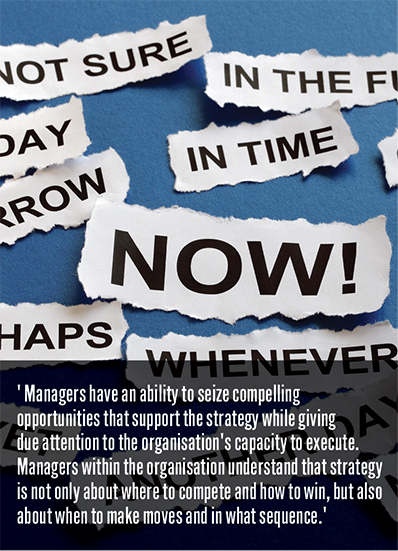Organisations that deliver – five elements that set the best apart from the rest
by Abhishek Chhikara & Debbie Williams
Right Thinking
Does your organisation have what it takes to successfully execute its strategy? Five elements set the best apart from the rest.
Winning organisations:
- Cascade their strategies successfully
- Effectively prioritise and sequence activities
- Create alignment within and across teams
- Adopt an effective approach to decision-making
- Commit to accountability for outcomes
Strategy without execution is just a collection of ideas – executing on it requires committed effort across the organisation. Leaders cannot stand back and watch after articulating the strategy; instead they need to roll up their sleeves and actively engage the organisation, addressing all five elements of effective strategy execution.
 In previous Right Lane Review articles, we have shared our approach to setting a clear strategic direction (Levy 2016, Williams, Chhikara & Levy 2017). But once you have a clear strategic direction, what next?
In previous Right Lane Review articles, we have shared our approach to setting a clear strategic direction (Levy 2016, Williams, Chhikara & Levy 2017). But once you have a clear strategic direction, what next?
While it has become a management truism that strategy execution is at least as important as strategy development, we have observed that it often remains an afterthought within organisations, with predictable results.
It should pay then to look to leading organisations. We believe that the organisations that are best at strategy execution share five common elements – abilities to successfully cascade their strategies; effectively prioritise and sequence activities; create alignment within and across teams; adopt an effective approach to decision-making; and commit to accountability for outcomes.
1. Cascade the strategy
The strategy is well understood, and activity is aligned to it throughout the organisation. There is a simple strategy and planning ‘architecture’, not piles of unlinked strategies nor layer upon layer of plans.
Employees are able to describe how the strategy affects their priorities and guides their choices. Individuals’ responsibilities and activities are clearly linked to the strategy, so everyone knows how they contribute to delivery. Language used in the strategy becomes part of the everyday and feels natural. There are visual reminders of the strategy in shared spaces (see Spiteri 2013).
 2. Effective prioritisation and sequencing of activities
2. Effective prioritisation and sequencing of activities
Managers have an ability to seize compelling opportunities that support the strategy while giving due attention to the organisation’s capacity to execute. Managers within the organisation understand that strategy is not only about where to compete and how to win, but also about when to make moves and in what sequence.
It’s striking to us that many large organisations try to do everything at once and overcommit to initiatives, while start-ups and early stage organisations are more inclined to artfully choreograph their steps and stop initiatives more quickly when they falter or fail to deliver.
Helping a team to understand what good looks like, where they are today and what the opportunities are to improve, is a good place to start. Outcomes of this work may include a set of prioritisation and sequencing principles; for example, the team may decide to: align to a set of prioritisation criteria based on urgency and importance; commit to prosecute two major initiatives and four ‘minors’ at any one time; agree to quarterly reprioritisation; or schedule initiatives over three time horizons.
3. Create alignment within and across teams
In organisations that are good at strategy execution, people understand their roles and responsibilities, and how their work supports others’ work – and information flows freely across organisational boundaries.
Sporting metaphors can be an apt way to identify opportunities for improvement within teams – to help colleagues understand the complementarity of their roles; to know when it is their turn to deliver; and to align to a simple game plan that gets results.
We suggest that teams conduct a role alignment exercise (Bregman 2013), involving everyone sharing their top five activities for the coming period and then working together to examine horizontal and vertical alignment between roles, and to clarify interdependencies.
We sometimes conclude strategy workshops by asking participants to share the distinctive role they can play in the delivery of the strategy. Having colleagues engage with each other’s ‘distinctive roles’ can help to foster alignment.
Alignment between teams can be increased by understanding each team’s perspectives and intentions; identifying joint ‘wins’ between teams; working to improve common processes; agreeing shared values and behaviours; and committing to ‘cadence of accountability’ (Kaplan & Norton 1996; McChesney, Covey & Huling 2012).
 4. Adopt an effective approach to decision-making
4. Adopt an effective approach to decision-making
Within the organisation, decisions are well informed, made in a timely manner and, once made, decisions are rarely second-guessed.
Effective decision-making can be the key to unlocking an organisation’s effectiveness. It starts by having a clear understanding of the problem you are trying to solve, and a set of guiding principles that inform decision-making. Every decision is different, from the impact it may have to the urgency and importance. Great decision makers categorise decisions and agree their approach to different categories – for example, how you make ‘big bet’ decisions versus what you delegate? The process is underpinned by a commitment to embedding effective decision-making and empowering employees (Deng 2018).
5. Commit to accountability for activities and outcomes
People within the organisation have a clear sense of the deliverables and outcomes they are accountable for and are able to rely on their colleagues to deliver on their commitments. Often in our work, we see organisations being explicit about the activities their employees are required to perform, but without properly anticipating the attendant results.
Both are important. Employees that are accountable for actions and not outcomes can waste time on work that isn’t making a difference; accountability for outcomes and not actions can undermine the proper functioning of management and efforts to understand value creation within organisations.
Performance should be reviewed formally and informally, with individuals and teams openly discussing the drivers of performance. There should also be processes in place to address persistent under-performance so that the culture of accountability is not undermined.
***
In our experience, organisations that struggle to deliver on their strategic aspirations face challenges with at least one or two of the elements mentioned above. We have found that running a strategy execution effectiveness diagnostic can help managers to identify where their organisation’s issues and challenges may lie, in order that improvement efforts can be targeted.
Strategy without execution is just a collection of ideas. An organisation that delivers is at once constantly making harmonious choices at all levels and is able take a collection of good ideas and turn them into concrete results. So, at the start of the next strategy and planning cycle, consider whether your organisation has what it takes to deliver.
References
Bregman, P 2013, ‘A personal approach to organisational time management’, McKinsey Quarterly, January.
Deng, L 2018, ‘Decision-making: a key to unlocking your organisation’s potential’, Right Lane Review, June.
Kaplan, R & Norton, D 1996, ‘Using the Balanced Scorecard as a Strategic Management System’, Harvard Business Review 74, no. 1, pp. 75–85.
Levy, M 2016, ‘Strategic thinking before strategic planning’, Right Lane Review, May.
McChesney, C, Covey, S & Huling, J 2012, The 4 Disciplines of Execution, 1st edition, Free Press.
Spiteri, L 2013, ‘Seeing is believing: visual metrics displays’, Right Lane Review, December.
Williams, D, Chhikara, A & Levy, M 2017, ‘The value of a robust diagnosis’, Right Lane Review, December.
For more information contact Abhishek Chhikara at abhishek.chhikara@rightlane.com.au or Debbie Williams at debbie@rightlane.com.au
© 2018 Right Lane Consulting
